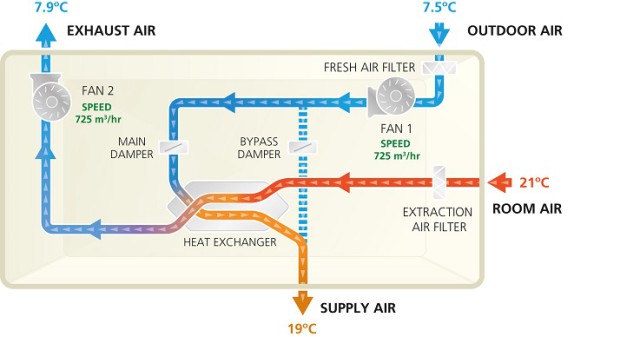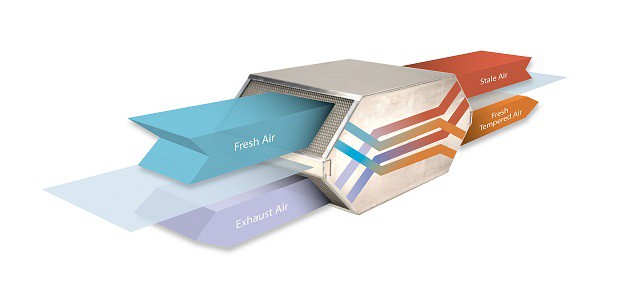Clean air for all

Spotlight on Smart Mechanical Ventilation (SMV) - insights shared by Jonathon Hunter Hill of AirMaster SMV
Achieving a consistently high-quality indoor environment in classrooms is critical to children’s ability to learn. There is evidence to show that Carbon Dioxide (CO2) concentrations of above 1,000 parts per million (ppm) in any space strongly impact one’s cognitive ability. This effect (The Bohr Effect) is amplified when we consider that classrooms are typically 60 m2 with an occupancy of 32. This is felt in the form of tiredness and a lack of concentration that a stuffy room can cause. Proper ventilation has therefore become a key talking point when considering optimal indoor environments that are both comfortable and energy efficient.
BB101: Guidelines on ventilation, thermal comfort, and indoor air quality in schools stresses the importance of proper ventilation in classrooms. The guidelines highlight a spectrum of ventilation strategies ranging from natural ventilation, in the form of opening windows, to centralized mechanical ventilation, each having its own advantages and disadvantages. While natural ventilation has been the historic solution in the UK, energy efficiency, air pollution and viral transmission make the use of natural ventilation less appealing.
With COVID-19, air pollution, and controlling CO2 factoring strongly into design decisions, manufacturers of mechanical ventilation systems are finding themselves in the spotlight. By using mechanical ventilation with heat recovery, filtered fresh air can enter classrooms at a controlled flow rate, without the risk of draughts typically associated with naturally ventilated spaces.
Within the mechanical ventilation space, there are dramatic differences between equipment types. Decentralized mechanical ventilation is vastly different from centralized mechanical ventilation, both in the mechanics of the equipment and in the control strategies. This article therefore aims to put a spotlight on Smart Mechanical Ventilation (SMV). Under the categorisation of BB101 (Ventilation, thermal comfort and indoor air quality 2018), SMVs are categorised as duct-free ventilation with automatic bypass.
The workings of Smart Mechanical Ventilation
In essence, SMVs are decentralized mechanical ventilation systems with heat recovery. The term SMV can be equally applied to any system that monitors the indoor environment and reacts to changes to the environment, such as adjusting the flow parameters of the equipment. The goal of an SMV, in the case of classrooms, is to supply enough fresh air to the rooms to control indoor air quality, whilst reducing the risk of discomfort due to draughts. SMVs consist of a pair of ductwork connections, a matching pair of fans, filters, dampers, and a heat exchanger.
To explain the unit’s operation more thoroughly, on the intake pathway fresh air is pulled from outside, where it is filtered before being passed through both dampers and the heat exchanger. In the heat exchanger, it picks up heat from the extracted air, before being supplied into the room for distribution. On the extract pathway, air is pulled from the room where it is filtered before passing through the heat exchanger, giving off up to 92% of its heat. It is then exhausted to outside by a fan at the rear.
SMVs like SAV System’s AirMaster make use of heat recovery and the Coanda effect to distribute air within classrooms evenly whilst avoiding draughts. The air enters the room at a velocity of 3 to 4 metres per second at a Delta T of approximately 2°C below room temperature. This enables the sub-cooled air to stick to the ceiling, to carry it across the classroom. As it makes its way across the ceiling surface, the fresh air will mix with the air already in the room, increasing in temperature and reducing in velocity. Therefore, by the time the fresh air makes its way into the occupied zone, its temperature should be close to the room temperature, with a velocity of approximately 0.15 metres per second. This enables an ample supply of air to classrooms with no risk of draught.
If the Coanda effect is the lungs of the SMV, the heat exchanger is the heart. Whilst air is entering the room, the air already in the room containing a great deal of CO2 and heat energy, is extracted. This warm, soiled air is passed through both a filter and the heat exchanger before being exhausted too outside. The exhaust air is ejected as a high-pressure jet, preventing it from being recirculated into the supply duct, which has a much lower pressure and lower entry velocity.
Every SMV has several different temperature control processes which are used to maintain the ΔT of 2°C throughout the year, all of which work in parallel with one another. On a daily basis, one of three processes will take place, which we call balanced ventilation, fan differential, and automatic bypass.
In the balanced ventilation mode, the unit will be achieving the supply air temperature of 2°C below room temperature as designed. Both the main damper and heat exchanger bypass damper adjust to mix up or down the supply air temperature as required within a 1°C tolerance band.
If the supply air temperature falls below the tolerance band, the SMV may enter the fan differential mode, in which the intake fan reduces its throughput by a small percentage, whilst exhaust fan speed remains the same. The same amount of heat is extracted from the room, but the supply air moves through the heat exchanger at a lower velocity. As such, more heat can be picked up by the supply air, increasing air temperature.

If the supply air temperature exceeds the tolerance band, the SMV may enter the automatic bypass mode were the supply air bypasses the heat exchanger. The bypass opens in small increments mixing down the supply air temperature. If the room temperature is too high, the bypass will open fully, bypassing the heat exchanger, introducing the cooler outdoor air to the classroom.
During summertime, there is a high risk of well-insulated buildings overheating, so whilst the automatic bypass mode may reduce the supply air temperature, the building may continue to overheat. The SMV will activate the night-time cooling mode, whereby air is brought in overnight to cool the thermal mass of the room to act as a heatsink the following day. This process will continue until the SMV has measured a successful reduction in day-time room temperature.
Most SMVs are fitted with CO2 sensors, enabling demand control year-round. To allow for monitoring of the SMVs, they can be fitted with online ethernet modules, which enable remote monitoring of the equipment via an Internet of Things (IoT) platform, or the digital BMS system by way of an application programming interface (API).
The benefits of Smart Mechanical Ventilation
In making use of the temperature and indoor air quality control functions built into SMVs, the practical operation of the systems becomes very simple. They are easy to install, have a low impact on the building construction, requiring only a pair of penetrations, mounting brackets, and electrical connection, and are plug and play. The result is a simple method of providing fresh, draught free air into well-insulated rooms, whilst recovering great amounts of energy already in the room.
SMVs normally have a very low fan power for MVHR, ranging from 0.50 to 1.24 W/l/s. This is made possible by the nature of a decentralized ventilation unit: the air reaching the unit must travel a very short distance to the fans, meaning that pressure drop is minimal. Furthermore, the Coanda effect requires a low pressure to operate, so specific fan powers can be kept to a minimum.
When we combine a low specific fan power and a high heat recovery efficiency, the holistic energy consumption of a classroom’s building services could be cut by as much as 40%. We estimate that the average hybrid ventilation system in a classroom has an average annual electrical and heating demand of approximately 600 kWh. We estimate that for an SMV, the combined demand is approximately 256 kWh annually. This is made possible by the dramatic reduction in heating demand.
When considering the energy consumption of classroom ventilation systems, it is therefore vital that one considers both the electrical and heating demand, as looking at the electrical demand only can be misleading. More information on this can be found in our document entitled, “Decarbonizing UK School Ventilation” and is available on our website.
The future of ventilation
There is no doubt that mechanically assisted ventilation will become the desired ventilation solution in resolving our indoor air quality needs. However, we should be aware the mechanical ventilation category is not comprised of one monolithic technology, but a combination of differing technologies and strategies. For classrooms, one of the most beneficial ventilation strategies is SMVs. By combining efficient heat recovery ventilation and low specific fan powers, classrooms fitted with SMVs can expect good air quality with a low carbon footprint, all without teacher-intervention.







